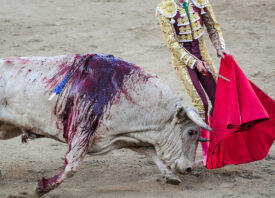Search this site
Shedding Light on the Brutal Truth at the Heart of the Meat Industry


When the photojournalist Jo-Anne McArthur, the Founder and Executive Director of We Animals Media, traveled to the Turkish-Bulgarian border to cover the live transport of animals, she discovered that a pregnant cow had given birth inside one of the trucks. The young calf was very weak, dehydrated, and in serious pain.
This situation is not uncommon on these multi-tiered live transport trucks, where animals farmed for meat travel for days or weeks on their way to slaughter. In some trucks, summer temperatures reached more than 103 degrees Fahrenheit, with the animals unable to access water. The containers become filled with urine and feces. Many of them stop mooing, possibly due to exhaustion.
“I want people to see inside the trucks the way I’m here seeing inside the trucks–so that they can know, so that they can care, so that they can change,” McArthur told the filmmaker Miguel Endara. The two worked together to create Moving Animals, a new short film about the transport and slaughter of animals trapped in an industry built by humans.
Almost two billion cows, pigs, sheep, and other farmed animals withstand these brutal journeys across borders around the world every year. Many collapse and die before reaching their final destination. Those who survive the trip are sent to sale yards and slaughterhouses; 160 million animals are transported to a slaughterhouse every day.
During her time at the Turkish-Bulgarian border, McArthur worked alongside Eyes on Animals, an animal-welfare organization based in The Netherlands, and a journalist from The Guardian. At one point, she remembers seeing a truck pull up in the shade, leaving a small space between the caging and nearby trees. The cows’ muzzles pressed up against the truck, as their tongues strained to reach the leaves, hungry and thirsty.
Later, she accepted an invitation to document the installation and use of a captive bolt gun at a local slaughterhouse. She witnessed cows being led by ropes, put into position, and killed. She saw them hanging by ropes, sometimes still conscious, and she saw them skinned, dismembered, and decapitated. Documenting this story, McArthur asked herself a question she’s considered time and again throughout her career, one that continues to haunt her today: “Why did we ever think this was okay?”
“What sticks with me–which is very, very, very hard–is the trust that these animals had up until the bolt went in their head,” she told Endara. “They’re scared about what’s happening, but they trust, and they go. They just trust, because it’s all they have. They don’t have any autonomy in life. Everything is dictated for them, from the moment they’re born, and they trust that we’re going to do well by them.”
The calf who was born on the truck at the Turkish-Bulgarian border ultimately received veterinary care when Eyes on Animals immediately intervened and got help from a vet named Ibrahim Sarigöz. After a while, he became well enough to nurse from a lactating cow, who might have been his mother, though there was no way to know.
“Sarigöz worked on helping the calf over the course of two days, but we were not allowed to take the calf, as no one knew really who he belonged to,” McArthur tells us. “He was named Ibo, by Lesley Moffat, the director at Eyes on Animals. Ibo is short for Ibrahim; he was named after the vet. We have since lost track, but we did learn that Ibo went to live at a farm where he would not be killed.”
We can all help animals like Ibo and the many who were slaughtered by sharing the film. To learn more about We Animals Media and the work they do on behalf of animals, check out their website, and follow along on Instagram, Facebook, and Twitter. You can support their work here.




